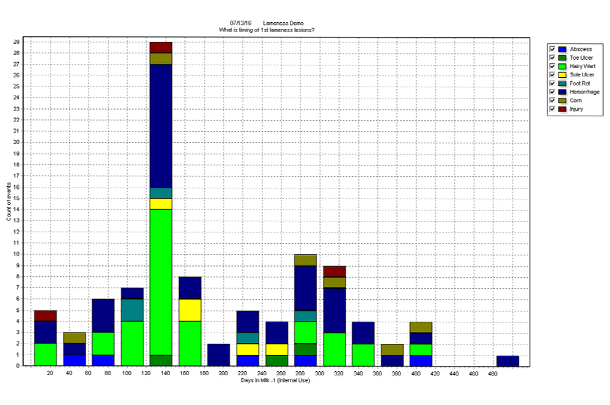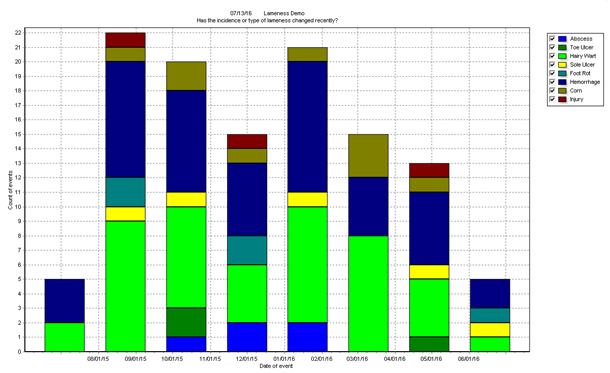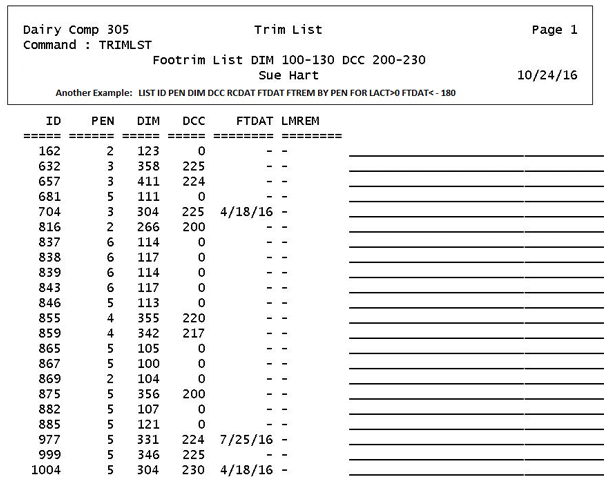Lameness can be the most costly disease on dairies, even more so than mastitis. This is due to the high incidence of lameness on dairies. It is not uncommon to find 30 percent yearly incidence or higher on dairies. Yet lameness is one of the least entered and tracked disease.
Lameness affects production, reproduction and how long the animals will be in the herd. Lameness is often neglected because early symptoms are subtle and the cow’s natural instinct is to hide her discomfort. This causes failure of early recognition and timely treatment. DC305 has developed a system for recording and analyzing “LAME” and “Foot Trims.” It standardizes LAME protocols and entry, and works cleanly with Pocket Trimmer. This is the Lameness Manager.
Using the Lameness Manager allows dairies to have a way to easily set up trim lists, recheck animals, add animals observed lame and be sure no animals are missed. It then allows for quick and easy data entry of trim and lame results with the use of protocols. Once this has been achieved, you are able to analyze the data showing lameness incidence, how many animals are being trimmed, if protocols are being followed and most importantly, help you discover why animals are becoming lame. You are able to look at the type of lesions and incidence by pen or lactation group, helping you narrow down possible causes of lameness. (See the graphs below.)
Click on the images above to view them in more detail.
To set up the Lameness Manager you will need to have the following items:
- MKDAT – type 18, milk withhold date
- BFDAT – type 18, beef withhold date
- LTDAT – type 18, date of last treatment
- PN – type 1, previous pen
- HPDAT – type 18, hospital entry date
- RCDAT – type 18, recheck date
- THD – type 1, total hospital days
If you do not have these items, they can be added using ALTER\2.
You will also need to have the event LAME. To verify you have it, use ALTER\9.
Then use ALTER\7 and click on the “advanced” tab to set up the Lameness Manager. First choose the menu “set up items” and make sure one through nine are defined. Then choose the menu “Lameness Manager.” Be sure the event and item are defined at the top. Then choose below the lesions you will be entering, along with the “trim only.” Then click on “install lame system.” You will be prompted for which item is your foot trim date; it will find the most logical one, but verify it is correct.
Once Lameness Manager is installed, it will enter in a foot trim date on all the animals. If there is not one entered this lactation and it is a lactating animal, the fresh date will be used. If it is a lactation zero animal, it will receive the birth date. Lameness Manager, from install forward, will keep the foot trim date across lactations. Now you are able to create a foot trim list with all animals needing attention on foot trim day. (See the example of the trim list below.)
Click on the image above to view it in more detail.
Having complete and accurate records will assist in evaluating hoof care, reducing the lame incidence on the dairy and reducing economic loss due to lameness.
– Article submitted by VAS
View the previous tip, PROTOCOLS.
PHOTOS: Photos provided by Valley Agricultural Software.






